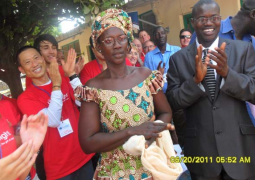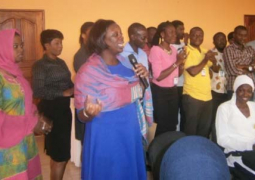Continuation
Modernization followed in the 1960s, with revolutions in the game such as the George Eastham case allowing players greater freedom of movement, and the abolition of the maximum wage in 1961.
Tottenham Hotspur became the first club to win the Double in the 20th century in 1960-61, and the first English club to win a European trophy, the UEFA Cup Winners’ Cup in 1962-63 when they beat Atlético Madrid 5–1 in the final.
The most marked success of the era, however, was Alf Ramsey’s England team, which won the 1966 FIFA World Cup on home soil after controversially beating West Germany 4-2 after extra time, the only time the national team has won the trophy.
In the late 1960s English clubs dominated the last years of the Inter-Cities Fairs Cup. In 1966–67 Leeds United reached the final where they lost 2–0 to Dinamo Zagreb. The following season they went one better, beating Ferencvárosi 1-0 in the final.
Newcastle United won the 1968–69 Inter-Cities Fairs Cup beating Újpest 6-2 in the final. The following season Arsenal made it a hat-trick of English triumphs beating Anderlecht 4-3 in the final. In the last Inter-Cities Fairs Cup in 1970–71, Leeds United were winners once again, when they beat Juventus on away goals.
Manchester United became the first English club to win the European Cup in 1967–68 when they beat Benfica 4–1 at Wembley in the final.
However, it was Liverpool who dominated the game in England from the early 1970s onwards, for nearly two decades. They won eleven league titles and four European Cups between 1972 and 1990.
Other successful clubs in the 1970s and 1980s included their rivals Nottingham Forest, who won a league title and two European Cups in the late 1970s, and Everton, with two titles in the mid-1980s, and Aston Villa with a European Cup triumph in 1982.
However while club sides thrived in European competition, the national team struggled, failing to qualify for both the 1974 and 1978 World Cups.
By this time serious problems had surfaced. The rise of football hooliganism marred the game throughout the 1970s and 1980s, with attendances dipping.
In August 1974, a Blackpool fan was stabbed to death at the back of the Spion Kop, Bloomfield Road at Blackpool’s home match with Bolton Wanderers.
It was widely reported as being the first hooligan death at an English football match and together with Manchester United fans’ behaviour, during their one season in the Second Division that year; it ushered in a dark era of hooliganism in England.
The nadir came in 1985, when Liverpool fans hooliganism, combined with poor policing and infrastructure, led to the deaths of 39 Juventus fans before the European Cup final, in the Heysel Stadium disaster. English clubs were banned from Europe for five years as a result. England’s ageing and poorly-built stadiums were responsible, along with other factors, for two disasters, one at Bradford in 1985 and the other at Hillsborough in 1989, killing 56 and 96 people respectively.
It is important to note how ‘fans hooliganism, combined with poor policing and infrastructure,’ can have a negative impact on the game in any country.
Hooliganism at football matches is not as bad in The Gambia as in England but it is growing and serious incidents with fans and referees being seriously injured have occurred recently mainly due to lack of security.
Lack of proper infrastructure (e.g. pavilions, changing rooms, toilets, fence, grassed playing field, etc) in most of our sports fields is one of our major problems in The Gambia and it is having a very negative impact on the number of people coming to watch football matches, especially during the rainy season and nawettan competitions, and the status of the game in general.
Without proper sports infrastructures and facilities it’s impossible to develop football. Local authorities (who own most of the existing sports fields) must be encouraged to invest (or find investors) in sports infrastructural development and facilities.
According to Wikipedia, “Up until the 1985–86 season there was no direct promotion and relegation between the Football League and non-league football, with the bottom four clubs in the Fourth Division each year having to apply for re-election for the following season.
A few non-league clubs were successful forcing league clubs to leave the Fourth Division, such as Hereford United.
However, in 1986–87 automatic promotion and relegation was introduced, with the bottom club in the league being relegated to the Conference. Eventually this was increased to two clubs in 2002–03.
In the 1980s, play-offs were introduced throughout the Football League for promotion each season, with one club each season being promoted via the end of season play-offs in addition to those clubs promoted automatically.
The post-Hillsborough Taylor Report forced the conversion of major stadia to all-seater. At the same time, the money from television coverage was increasing rapidly. These, combined with England’s relative success at the 1990 World Cup, reaching the semi-finals only to lose on penalties to West Germany, and a concerted effort to drive out hooliganism reinvigorated the national game.
In the spring of 1992, the 22 clubs in the First Division resigned en masse from the Football League, forming a new top-level competition, The FA Premier League, overseen by The FA, largely to capitalize upon their status as the biggest and most wealthy clubs in the country, and negotiate more profitable television rights.
The Football League was consequently re-organised, with the Second, Third and Fourth Divisions renamed as the First, Second and Third Divisions respectively. Thus, the First Division, while still the top level of the Football League, became the second level of the entire English football league system with the top clubs inheriting the promotion playoff system from the old Second Division.
1992 was another major turning point in the development of English football with the eventual formation of the FA Premier League.
To me we are also presently at a major turning point in the development of Gambian football and the decision we make today with our adopted GFA constitution and the League will make or break the future of our football game.
The important lesson to learn from this event is that football for many years in England was dominated and totally controlled (from administrating the rules of the game to sponsorship deals) by the English FA.
The 22 clubs of the First Division Football League decided to come together and control their own destiny by dictating and controlling how the organization and financing of their League is to be organised and money spent.
Despite the resistance of the FA they succeeded. In the case of The Gambia, my advice is for the Regional Organizing Committee (ROC) with their Nawettan Centers Organizations, Nawettan Centers football clubs, Municipality, Local Councils and all interested GFA League clubs should come together at a series of meetings and draft a new GFA Constitution and a new nationwide Football League as soon as possible.
A national Football League Committee (FLC) composed of all the main Nawettan Centers and Super Nawettan football clubs should be formed as soon as possible.
To be continued





